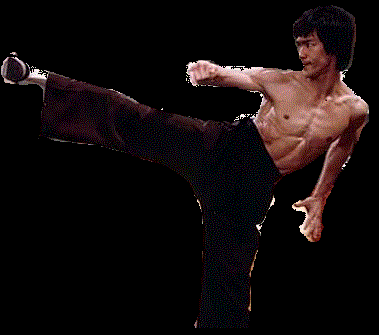Shotokan
Shotokan (松濤館 Shōtōkan) is a style of karate, developed from various martial arts by Gichin Funakoshi (1868–1957) and his son Gigo (Yoshitaka) Funakoshi (1906–1945). Gichin was born in Okinawa and is widely credited with popularizing "karate do" through a series of public demonstrations, and by promoting the development of university karate clubs, including those at Keio, Waseda, Hitotsubashi (Shodai), Takushoku, Chuo, Gakushuin, and Hosei.
Funakoshi had many students at the university clubs and outside dojos, who continued to teach karate after his death in 1957. However, internal disagreements (in particular the notion that competition is contrary to the essence of karate) led to the creation of different organizations—including an initial split between the Japan Karate Association (headed by Masatoshi Nakayama) and the Shotokai (headed by Motonobu Hironishi and Shigeru Egami), followed by many others—so that today there is no single "Shotokan school", although they all bear Funakoshi's influence. Being the biggest school, Shotokan is considered a traditional and influential form of karate do.
Shotokan was the name of the first official dojo built by Gichin Funakoshi, in 1936 at Mejiro, and destroyed in 1945 as a result of an allied bombing. Shoto (松濤 Shōtō), meaning "pine-waves" (the movement of pine needles when the wind blows through them), was Funakoshi's pen-name, which he used in his poetic and philosophical writings and messages to his students. The Japanese kan (館 kan?) means "house" or "hall". In honor of their sensei, Funakoshi's students created a sign reading shōtō-kan, which they placed above the entrance of the hall where Funakoshi taught. Gichin Funakoshi never gave his system a name, just calling it karate.
Shotokan training is usually divided into three parts: kihon (basics), kata (forms or patterns of moves), and kumite (sparring). Techniques in kihon and kata are characterized by deep, long stances that provide stability, enable powerful movements, and strengthen the legs. Shotokan is often regarded as a 'hard' and 'external' martial art because it is taught that way to beginners and coloured belts to develop strong basic techniques and stances. Initially strength and power are demonstrated instead of slower, more flowing motions. Those who progress to brown and black belt level develop a much more fluid style that incorporates grappling and some aikido-like techniques, which can be found in the black belt katas. Kumite techniques mirror these stances and movements at a basic level, but are less structured, with a focus instead on speed and efficiency.
Gichin Funakoshi laid out the Twenty Precepts of Karate, (or Niju kun) which form the foundations of the art, before some of his students established the JKA. Within these twenty principles, based heavily on Bushido and Zen, lies the philosophy of Shotokan. The principles allude to notions of humility, respect, compassion, patience, and both an inward and outward calmness. It was Funakoshi's belief that through karate practice and observation of these 20 principles, the karateka would improve their person.
The Dojo kun lists five philosophical rules for training in the dojo; seek perfection of character, be faithful, endeavor to excel, respect others, refrain from violent behavior. The Dojo kun is usually posted on a wall in the dojo, and some shotokan clubs recite the Dojo kun at the beginning and/or end of each class to provide motivation and a context for further training.
Kata:
Kata is often described as a set sequence of karate moves organized into a pre-arranged fight against imaginary opponents. The kata consists of kicks, punches, sweeps, strikes and blocks. Body movement in various kata includes stepping, twisting, turning, dropping to the ground, and jumping. In Shotokan, kata is a performance or a demonstration, with every technique potentially a killing blow (ikken hisatsu)—while paying particular attention to form and timing (rhythm). As the karateka grows older, more emphasis is placed on the health benefits of practicing kata, promoting fitness while keeping the body soft, supple, and agile.
Several Shotokan groups have introduced kata from other styles into their training. The original Shotokan kata syllabus is introduced in Funakoshi's book Karate-do Kyohan, which is the Master Text of Shotokan karate. Dai Nihon Karate-do Shotokai is the official representative of Shotokan karate. Japan Shotokai's kata syllabus is the same as established in "Karate-do Kyohan" added Gigo Funakoshi's staff kata Matsukaze No Kon.[8] When the JKA was formed, Nakayama laid down 27 kata as the kata syllabus for this organization. Even today, thousands of Shotokan dojo only practice 26 of these 27 kata.






